

Dear Hiver...
There is in Havana a park beautifully illuminated by the tropical sunlight, the beauty of the buildings that surround it and the smiles of Cubans and foreigners who find peace and quiet in the midst of the hectic city life, as well as those who meet to discuss baseball, those who cross it to move between the important boulevards and commercial axes of Obispo and San Rafael. It is also a must for tourists visiting the city, both for its strategic location, as well as for the group of first class hotels and the outstanding cultural institutions that surround its boundaries.
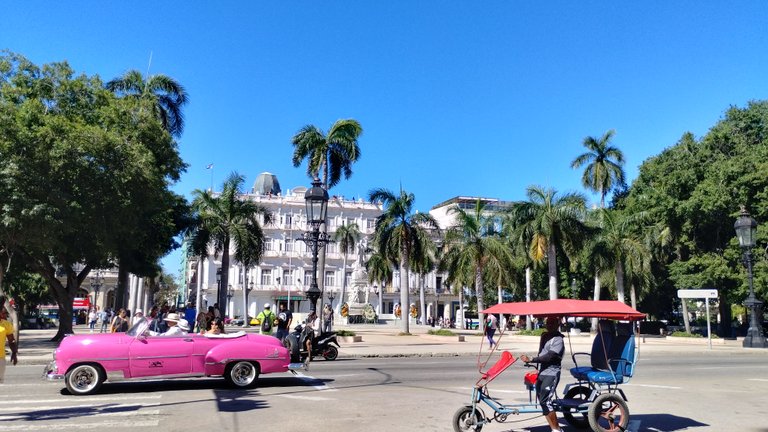
The Central Park delimited by San José, Zulueta, Neptuno and Prado Streets, was the first one built in Havana outside the walls, as a continuation of the Paseo del Prado. But it was not until 1877 when it reached its present size after the demolition of the old wall that enclosed what is known today as Old Havana.
In 1875 the Spanish authorities restored in its center the statue of Queen Isabella II (previously removed after the brief abolition of the monarchy), which remained there until the cessation of Spanish sovereignty over Cuba.
Subsequently, Mayor Perfecto Lacoste ordered to place in its place a Statue of Liberty, which was knocked down by a hurricane. Then the Cuban sculptor José Vilalta Saavedra was commissioned to build the current monument to our national hero José Marti, financed in part with donations from citizens and some government institutions. It was inaugurated on February 24, 1905 on the tenth anniversary of the beginning of the War of Independence. With the presence of the President of the Republic, Tomás Estrada Palma and General Máximo Gómez, who raised the Cuban flag and addressed a speech to the people in attendance.
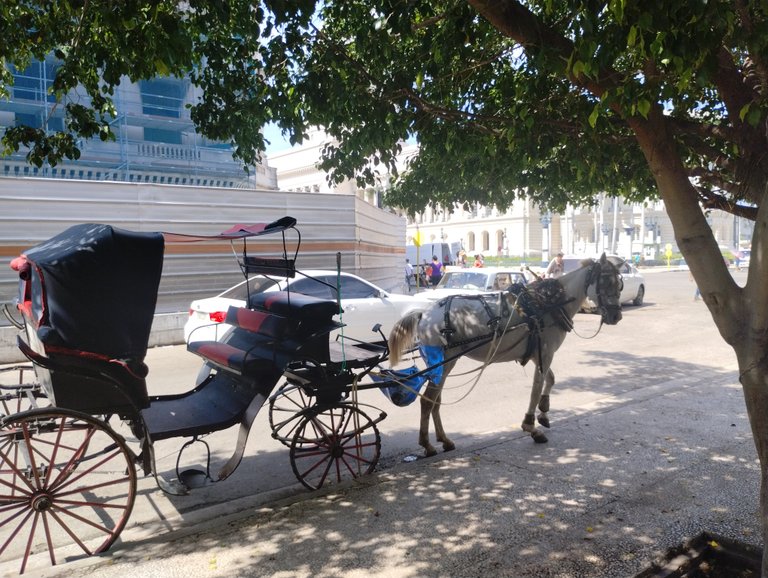

The vegetation was not much in the early years, until the greenery grew to give shade and beauty to this emblematic Havana park. This turns it into a place of rest and stroll for the animals that work for tourism and for the citizens that pass through it in the middle of their business in these places of Havana. Some trees, such as the 28 palms that pay homage to the birth of José Marti, were introduced as symbols. The same happens with the 8 planters that represent the symbolic tombs of the 8 medical students who were shot on November 27th, 1871.
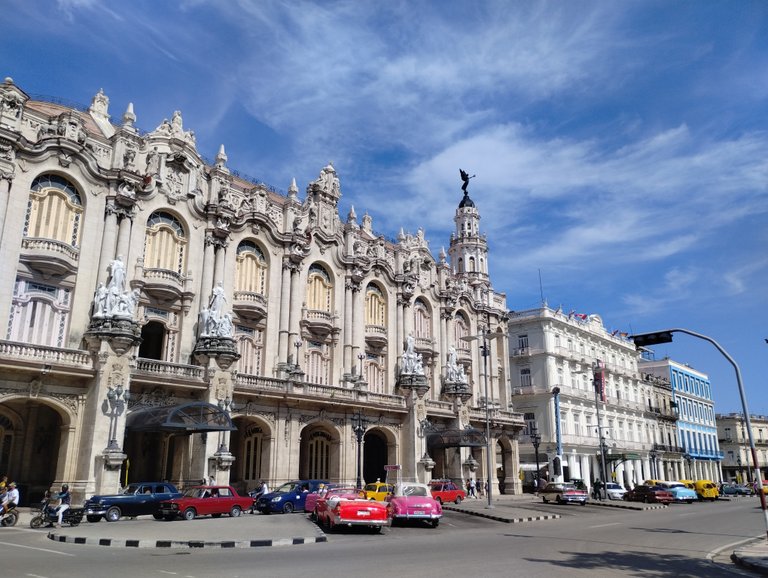
If we look to the north we could say that the park confronts on its west side with three important buildings. The Alicia Alonso Theater, the Inglaterra Hotel and the Telégrafo Hotel.
The site now occupied by the Gran Teatro de la Habana Alicia Alonso (named after the famous ballet dancer), was formerly the site of the Tacón Theater, designed by architect Antonio Mayo, inaugurated in 1838 and named after the Governor of Cuba, Miguel de Tacón y Rosique. It is said that it was the largest and most luxurious theater in the American continent. Later, in 1906, it was converted into the Social Palace of the Galician Center by the Belgian architect Paul Beleu, who gave it its present appearance. Since 1965 it has been the permanent headquarters of the National Ballet of Cuba and other dance institutions. Already in 1985 it was called Gran Teatro de la Habana... headquarters of the International Ballet Festival. In 2015 it was named Gran Teatro de la Habana Alicia Alonso, in recognition of this dancer, founder and director of the National Ballet of Cuba. I can tell you that I have been fortunate to attend several concerts and presentations of exquisite artistic quality in this theater. Including presentations of Alicia Alonso herself and I was also able to share with her in a small circle of artists after one of those presentations.

Located between the Gran Teatro Alicia Alonso and the Hotel Inglaterra is the Boulevard de San Rafael. An important promenade full of varied businesses, galleries and other institutions. Also impregnated with the colorful daily life of the Habaneros. Presiding over the entrance of the Boulevard is this beautiful bronze sculpture, dedicated to dance.
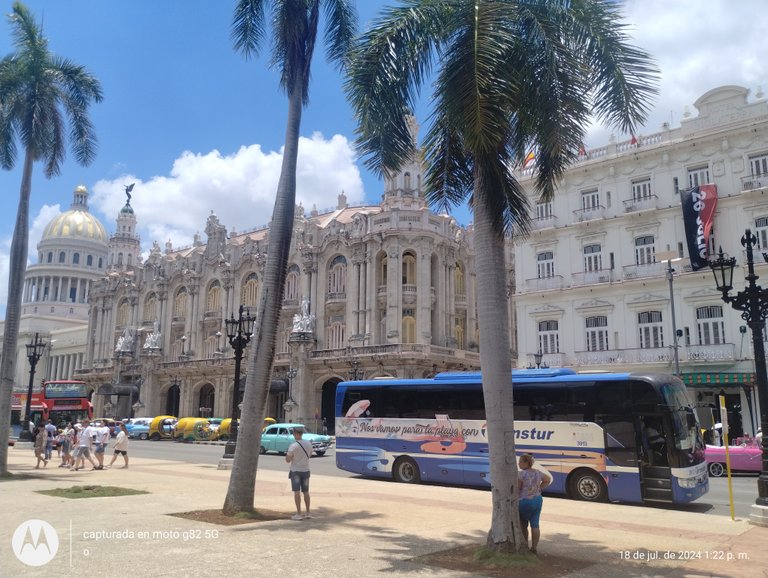
Next to the Theater and the Boulevard, and to the right of this photo, stands another important building of this city. The Inglaterra Hotel was founded on December 23, 1875. It has always been a refuge for important personalities of the culture, and has always been a place of national and international artistic show business. In its portals the bohemian life is active and enlivened with traditional Cuban music. For all the history that dwells within its walls, it was declared a National Monument in 1981.
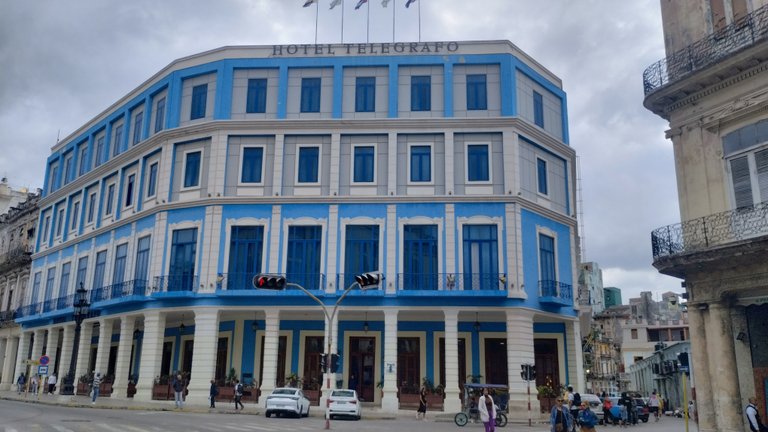
Next we will find the Hotel Telégrafo Axel Hotel, where a few years ago I found a magnificent exhibition of old devices used in communications. Its first hotel was opened in 1860, although it is since 1888 that it was located at this site, and so it had several owners until it became part of the Spanish chain.
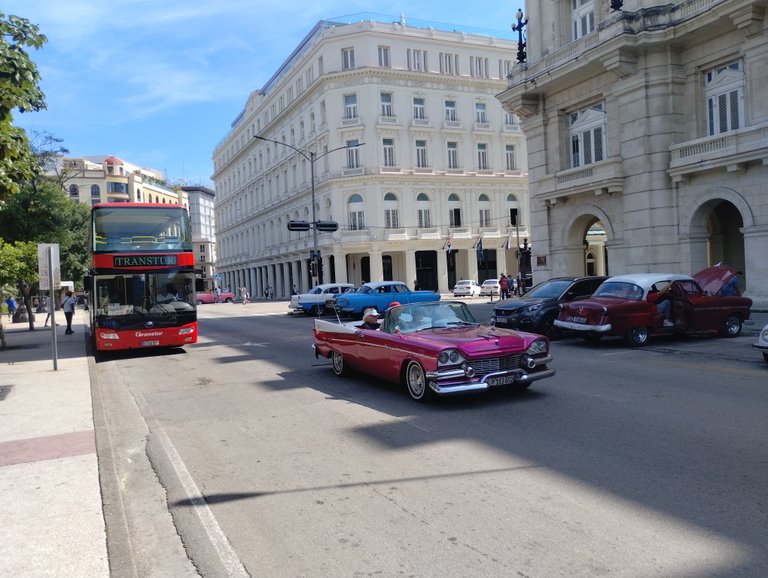
The eastern part of the Central Park borders the imposing buildings of the Universal Art Building of the National Museum of Fine Arts and the Gran Hotel Manzana Kempinsky. The avenue in between has a large confluence of cars. Especially old cars that work as cabs for tourists, also buses for city tours, bicycle cabs, carriages and others that make life more colorful around the park.
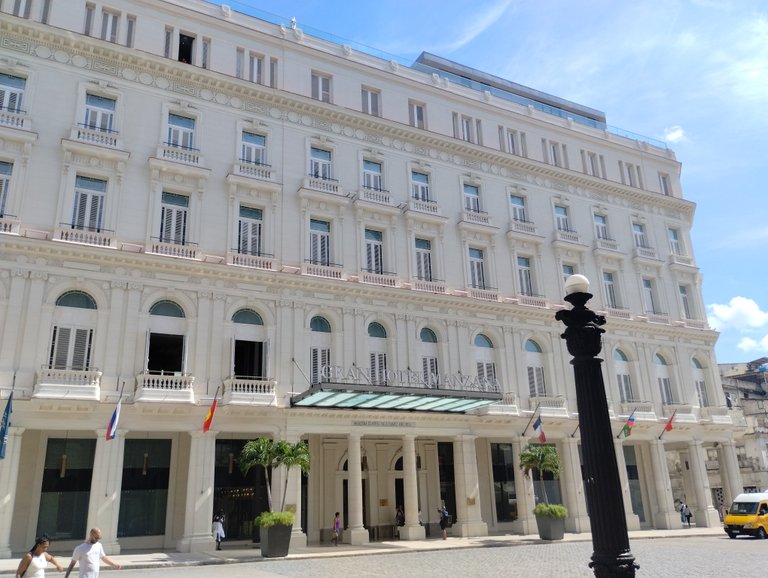

The Gran Hotel Manzana Kempinsky occupies the site of the famous Gómez block, which was the first luxury shopping center in Cuba since 1920. It is currently a 5-star luxury hotel, managed by Kempinski, a European hotel group. I recently had to go to the hotel to ask how to help some tourists with their internet connection and I can say that I was kindly treated by the staff.
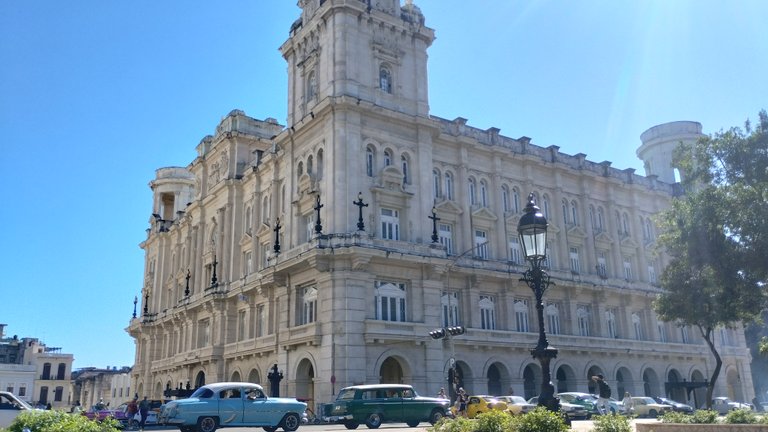
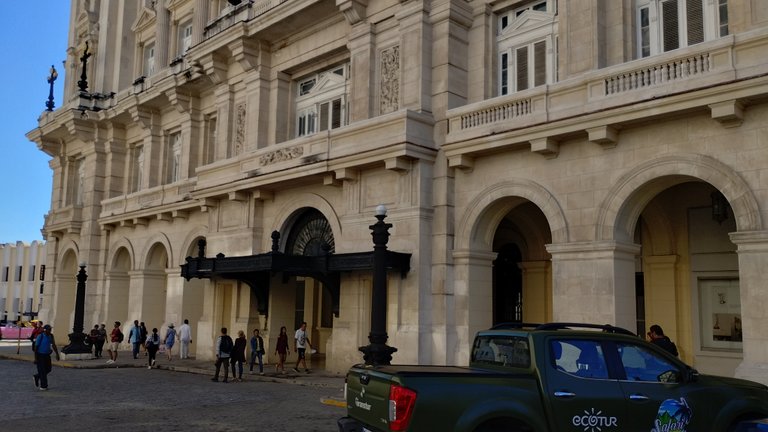
The Universal Art Building of the National Museum of Fine Arts is housed in a magnificent building designed by Spanish architect Manuel del Busto. This building was originally built as the headquarters of the Asturian Society of Havana, it was also the Pioneer's Palace and the headquarters of the Ministry of Justice. It was later restored by the historian's office and converted into a building to house the universal art collection of the National Museum of Fine Arts. A few months ago I participated in some workshops offered by Mexican artists in one of its spaces. It is of an incredible decorative beauty in its constructive spaces, and in it converge exhibitions of universal art both ancient and contemporary.

In the distance, behind the trees and adjacent to the north side of Parque Central, is the Hotel Iberostar Parque Central. This building occupies an entire block and also adjoins the Paseo del Prado. It was built on two buildings, one old and the other modern, connected by a subway tunnel.
I would like to show you pictures of the Payret Theater which is located in the southern part of the park, but it is currently covered by a system of aluminum and protective mesh because it is under repair...
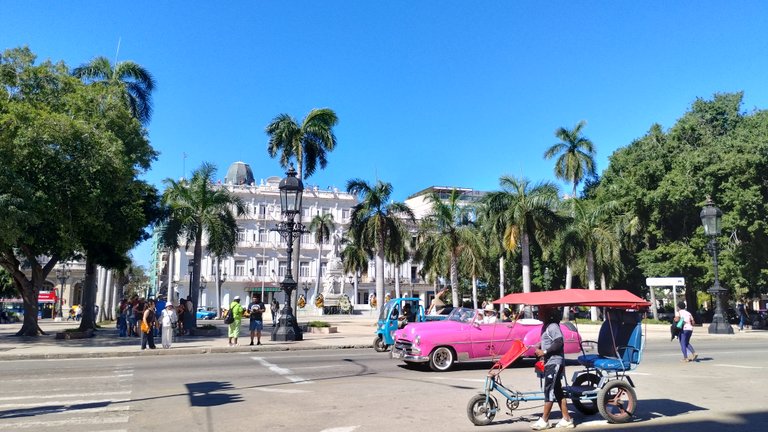
Lately, every time I visit Havana I walk through the Central Park, it is a beautiful place, full of life, color and culture. There, the historical and the contemporary mix and flow, building a new history of which I am also a part. The history of my ancestors, my family, my friends, my culture. It is a special place to sit for a while to talk, to laugh and enjoy the joy of living ....
Todas las imágenes son de mi propiedad. Tomadas con mi Motog82.
Traducido con deepl.com
SPANISH


Querido Hiver...
Existe en la Habana un parque bellamente iluminado por la luz tropical del sol, la belleza de las construcciones que lo rodean y las sonrisas de cubanos y extranjeros que en ese lugar encuentran el sosiego en medio de la agitada vida citadina, también de los que se reúnen a discutir sobre béisbol, los que lo atraviesan para transitar entre los importantes boulevares y ejes comerciales de Obispo y el de San Rafael. También es lugar obligatorio para los turistas que visitan la ciudad, tanto por su situación estratégica, como por el conjunto de Hoteles de primera línea y las destacadas instituciones culturales que rodean sus límites.

El Parque Central delimitado por las calles San José, Zulueta, Neptuno y Prado, fue el primero construido en la Habana extramuros, como una continuación del Paseo del Prado. Pero no fue hasta 1877 cuando alcanzó su actual tamaño tras la culminación del derribo de la antigua muralla que encerraba la hoy llamada Habana vieja.
En 1875 las autoridades españolas restituyeron en su centro la estatua de la reina Isabel II (removida anteriormente tras la breve abolición de la monarquía), la que se mantuvo allí hasta el cese de la soberanía de España sobre Cuba.
Posteriormente el Alcalde Perfecto Lacoste ordenó colocar en su lugar una Estatua de la Libertad, la cual fue derribada por un huracán. Entonces se le encomendó al escultor cubano José Vilalta Saavedra el actual monumento a nuestro héroe nacional José Marti, financiado en parte con donaciones de los ciudadanos y algunas instituciones gubernamentales. El mismo se inauguró el 24 de febrero de 1905 en el décimo aniversario del comienzo de la Guerra de Independencia. Con la presencia del presidente de la República, Tomás Estrada Palma y el Generalísimo Máximo Gómez, que izó la bandera cubana y se dirigió un discurso al pueblo asistente.


La vegetación no era mucha en los primeros años, hasta que el verdor fue creciendo para dar sombra y belleza a este emblemático parque habanero. Esto lo convierte en un lugar de reposo y paseo para los animales que trabajan para el turismo y para los ciudadanos que lo transitan en medio de sus gestiones por estos lugares de la Habana. Algunos árboles, como las 28 palmas que hacen homenaje al natalicio de José Marti, se introdujeron como símbolos. Igual sucede con las 8 jardineras que representan las tumbas simbolicas de los 8 estudiantes de medicina que fueron fusilados el 27 de Noviembre de 1871.

Si nos orientamos hacia el norte podríamos decir que el parque confronta en su lado oeste con tres importantes edificios. El Teatro Alicia Alonso, el Hotel Inglaterra y el Hotel Telégrafo.
El lugar que hoy ocupa el actual Gran Teatro de la Habana Alicia Alonso (nombrado así en homenaje a la famosa bailarina de ballet), fue antes sede del Teatro Tacón, obra del arquitecto Antonio Mayo, inaugurado en 1838 y nombrado así en homenaje al Gobernador de Cuba, Miguel de Tacón y Rosique. Dicen que era el teatro más grande y lujoso del continente americano. Después convertido desde 1906 en el Palacio Social del Centro Gallego, por obra del arquitecto Belga Paul Beleu, quien le dio la definitiva apariencia actual. Desde 1965 es la sede permanente del Ballet Nacional de Cuba, y otras instituciones de la danza. Ya en 1985 le llamaron Gran Teatro de la Habana...sede del festival internacional de Ballet. En el 2015 se le nombra Gran Teatro de la Habana Alicia Alonso, en reconocimiento a esta bailarina fundadora y directora del Ballet Nacional de Cuba. Les puedo contar que he sido afortunado de asistir a varios conciertos y presentaciones de exquisita calidad artística en este teatro. Incluyendo presentaciónes de la mismísima Alicia Alonso y también pude compartir con ella en un pequeño círculo de artistas después de una de esas presentaciones.

Situado entre el Gran Teatro Alicia Alonso y el Hotel Inglaterra está el Boulevard de San Rafael. Un importante paseo lleno de negocios variados, galerías y otras instituciones. También impregnado del colorido de la vida cotidiana de los Habaneros. Presidiendo la entrada del Boulevard está esta hermosa escultura en bronce, dedicada a la danza.

Próximo al Teatro y el Boulevard, y a la derecha de esta foto, se yergue otra importante edificación de esta ciudad. El Hotel Inglaterra fundado el 23 de diciembre de 1875. Poseído siempre por los aires de la farándula artística nacional e internacional ha sido siempre refugio para importantes personalidades de la cultura. En sus portales la vida bohemia es activa y amenizada con música cubana tradicional. Por toda la historia que habita entre sus paredes fue declarado Monumento Nacional en 1981.

A continuación encontraremos el Hotel Telégrafo Axel Hotel, donde hace unos años encontré una magnífica exposición de antiguos aparatos usados en las comunicaciones. Su primer hotel fue abierto en 1860, aunque es desde 1888 que lo situaron en esta sede, y así tuvo varios dueños hasta llegar actualmente a ser parte de la cadena española.

La parte este del Parque Central colinda con las imponentes edificaciones del Edificio de Arte Universal del Museo Nacional de Bellas Artes y del Gran Hotel Manzana Kempinsky. La avenida intermedia tiene una gran confluencia de autos. Especialmente autos antiguos que funcionan como taxis para turistas, también autobuses para paseos por la ciudad, bicitaxis, carruajes y otros que hacen más colorida la vida en los alrededores del parque.


El Gran Hotel Manzana Kempinsky, ocupa el lugar de la famosa manzana de Gómez, que fue desde 1920 el primer centro de compras de lujo en Cuba. Actualmente es un hotel de lujo 5 estrellas, gerenciado por Kempinski, un grupo hotelero europeo. Hace poco tuve que acudir al hotel para preguntar como ayudar a unos turistas con su conexión a internet y puedo decir que fuí amablemente tratado por el personal.


En un magnífico edificio, obra del arquitecto español Manuel del Busto se encuentra el Edificio de Arte Universal del Museo Nacional de Bellas Artes. Esta sede construida en principio como sede de la Sociedad Asturiana de la Habana, fue también Palacio de Pioneros y sede del Ministerio de Justicia. Posteriormente fue restaurada por la oficina del historiador y convertida en el edificio para albergar la colección de arte universal del Museo Nacional de Bellas Artes. Hace unos meses participe en unos talleres que ofrecieron artistas mexicanos en uno de sus espacios. Es de una increíble belleza decorativa en sus espacios constructivos, y en el confluyen exposiciones de arte universal tanto antiguo como contemporáneo.

A lo lejos, detrás de los árboles y colindante por el lado norte del Parque Central, esta el Hotel Iberostar Parque Central. Este edificio ocupa toda una manzana y también colinda con el Paseo del Prado. Su construcción se realizó sobre dos edificios, una parte antigua y otra moderna, unidas por un túnel subterráneo.
Me faltaría mostrarte imágenes del Teatro Payret que está en situado en la zona sur del parque, pero actualmente está cubierto por un sistema de aluminio y mallas protectoras pues se encuentra en reparación...

Últimamente, cada vez que visitó la Habana camino por el Parque Central, es un lugar hermoso, lleno de vida, colorido y cultura. Allí lo histórico y lo contemporáneo se mezclan y fluyen construyendo una nueva historia de la que también soy parte. La historia de mis antepasados, la de mi familia, mis amigos, mi cultura. Es un lugar especial para sentarse un rato a conversar, a reir y disfrutar de la alegría de vivir....
Todas las imágenes son de mi propiedad. Tomadas con mi Motog82.
Traducido con deepl.com
Those architectures look very beautiful ❤️ it's pretty old but well design.
It was a good time for Cuban arquitecture, they did it similar to europeans buildings...
You can check out this post and your own profile on the map. Be part of the Worldmappin Community and join our Discord Channel to get in touch with other travelers, ask questions or just be updated on our latest features.
Thank you Worldmapping! warm regards!
¡Con mucho gusto!
💪🗺️🐝
Thank you jishan5 for the support,! warm regards!
This is really a good post and I will curate this, but please be accurate in pinning your post to the map next time. I know the park is in Havana, Cuba, but your pin is in the middle of Havana Port. Please zoom in to the exact location before getting the code next time. Or when using PeakD, please zoom in to the exact location before clicking the pin. Thank you!
Thank you for telling me the right way to do it.....I still have a lot to learn...I did not know that I have to it that way...also because my internet is so slow that Is complicate to zoom deeper in the Map ...now I Know. Thanks you
Can I change the position now??
It's okay. You don't have to change the pin now. Just zoom in to the exact location next time like in your next travel post. Thank you!
Travel Digest #2492.
Become part of our travel community:
- Join our Discord
Hiya, @ybanezkim26 here, just swinging by to let you know that this post made it into our Honorable Mentions in Your post has been manually curated by the @worldmappin team. If you like what we're doing, please drop by to check out all the rest of today's great posts and consider supporting other authors like yourself and us so we can keep the project going!Thank you for the support....Yes I like the work you are doing ! great comumnity!
Keep up the great work 💪
Yes...there is beauty everywhere!